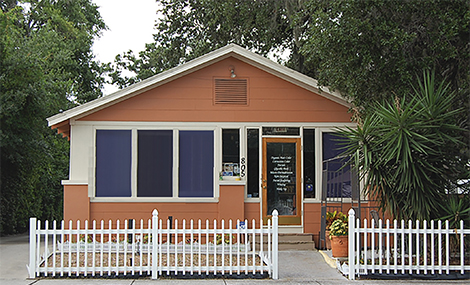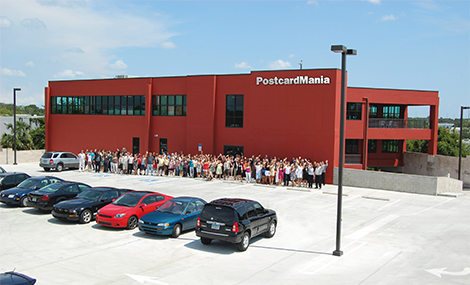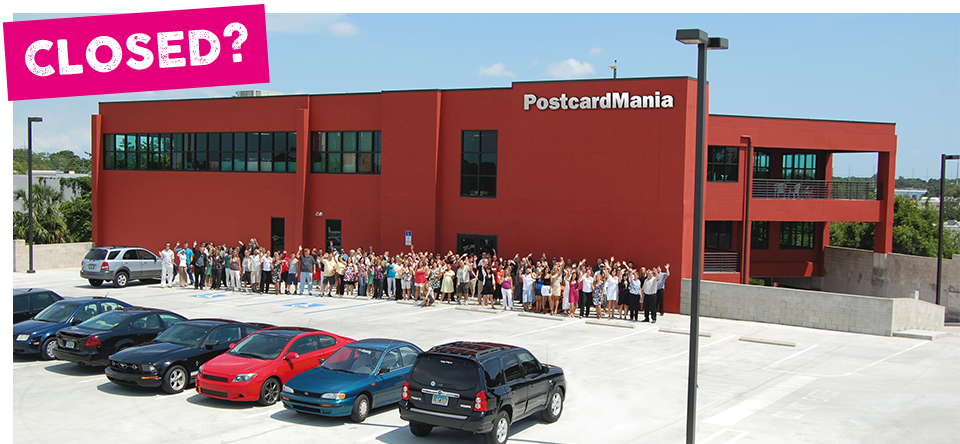
Joy is more than just a marketer...
She is a successful entrepreneur, accomplished speaker, business owner, author and philanthropist. She founded PostcardMania in 1998 with only a phone, a computer and her own marketing savvy — no capital injections or outside funding whatsoever. She had no MBA or formal business education either. In fact, Joy dropped out of high school at 16.
What began as a tiny startup in a 600-square foot cottage is now a bootstrapping success story.
About Joy's Journey as Founder/CEO of PostcardMania
It would take an entire book to tell you everything about Joy's entrepreneurial journey and the massive lessons she's learned along the way. So, we've boiled down a few select pivotal moments for you to read up on using these links:
Interested in interviewing Joy or having her speak at your event?

Joy is available for interviews on and off camera, or as a soundboard for journalists and editors looking to discuss a number of topics with a reliable source.
Her expertise extends to:
- Entrepreneurship
- Bootstrapping
- Marketing
- Direct Mail
- Website Design
- Programmatic Technology
- Commercial Printing
- Hiring and Retaining Talent
- And More
Please reach out with any questions.
For more information or to schedule an interview with Joy Gendusa, contact Jessica Lalau at:
pr@postcardmania.com
1-888-989-1426
Joy's Headshot:
PostcardMania Logo:
Helpful Links
Contact
Public Speaker
Learn More About Joy's Entrepreneurial Journey
How Joy continued to grow and evolve PostcardMania through the years

PostcardMania: 1998

PostcardMania: Today
But it hasn't always been smooth sailing. PostcardMania was actually founded after a terrible customer service experience with another commercial printer.
From the get-go, Joy bucked a number of industry norms. PostcardMania was the first postcard company to:
- Promote and sell directly to business owners rather than working exclusively through expensive agencies.
- Educate small business owners on the direct mail process and how to succeed at it.
- Offer mailing services in-house to speed up service and simplify the process
- Give away valuable marketing knowledge for which agencies had previously changed hefty fees and retainers.
By 2005, many of the policies that had set PostcardMania apart from its competitors had been copied and adopted widely within the direct mail industry. PostcardMania risked blending in, but that wasn't an option for Joy. She wouldn't settle for being just another printing company offering a commodity — a game that too-often devolves into a race to the bottom on price.
Joy knew that PostcardMania was more than just another printer. It was a marketing company with printing capabilities, consulting business owners day in and day out on campaign strategies.
She needed a way to show business owners that she cared first and foremost about marketing — and that meant showing them she cared about their results.
In 2005, Joy created a new department. within PostcardMania, the Results Department. She hired a Results Manager for the role of collecting successful campaigns from clients and cataloging key characteristics among those successes, like mailing frequency, mailing list demographics, design similarities and more.
Joy's idea quickly grew into a large vault of successful campaigns, which led PostcardMania to adopt a new data-driven, resultsbased approach to direct mail.
Today, that approach is still not replicated by PostcardMania's competitors. PostcardMania remains the only direct mail company to base their campaigns on the results of previous successes and results tracking.
PostcardMania's unique approach to results-based campaigns helped the company continue to grow year after year, despite an overall contraction in the print industry. In fact, PostcardMania's earnings have grown every year since it was founded, with the exception of 2009 — a year in which Joy almost lost the company.
Continue reading to learn more about that phase in PostcardMania's history...

The ultimate business test: almost losing PostcardMania
directly from the desk of Joy Gendusa, PostcardMania Founder & CEO
Quick background:
PostcardMania was founded in 1998, and most of our clients were in the mortgage and real estate industry. Their business basically sustained my business for 10 years.
Now, this story starts really in 2008, when the bottom fell out of (first) the real estate market and (then) our entire economy.
At that point, the real estate and mortgage industries made up 46% of my entire clientele.
We lost thousands of clients almost instantly, and our revenue dropped significantly. For the first time in the history of my company, we weren't growing and expanding from week to week, quarter to quarter — we were contracting, and fast.
The crazy thing was:
It wasn't even that bad for us until 2009. That's when our own crisis hit, almost a year after the housing crisis and market collapse.
In 2008, we were only down about $150,000.
But 2009 — that was another story. Some weeks, I wasn't even sure we could make payroll.
Operations quickly became unsustainable, and I knew we would have to make cuts somewhere.
I was dead set against laying anyone off. That was not an option for me.
If I wasn't going to cut staff, advisors told me that the next best option would be to cut our postcard marketing budget. They looked at the price of our postcard marketing per week and said, “Wow! You could save a LOT of money by cutting that way back.”
Against my better judgement, I listened and cut our marketing back.
As a result, new incoming leads and revenue suffered more than any of us could have anticipated.
Not only was 2008 our worst year yet — 2009 was even worse – we were down 15%. And 15% of $30 million is a hefty chunky of change. Cutting our marketing budget compounded our issues even further. Because we had fewer leads coming in overall, our revenue couldn't rebound.
Meeting payroll became my only objective. My business was surviving on week-to-week basis (the equivalent of paycheck-topaycheck), and only just barely. My finances were a mess. My hair went from black to entirely — and I'm talking entirely — white within one year. It was hell. I just have to say — thank gawd for hair dye!
Plus, I didn't pay myself much during that time... I cut my own pay by 75% and took a stipend so I wouldn't feel like it was all for nothing. I'm lucky I have a husband with a business and the crash actually helped his business!
So, after months of closely tracking and analyzing our numbers, I realized that in order to get revenue back on track, we needed to get leads back on track — and that meant sending more postcards.
I increased our marketing budget back to its pre-crash total, and our numbers quickly recovered. We made up lost ground and then some.
Why?
It all comes down to something that I instinctively knew to be true about marketing my business that my financial advisors couldn't see or understand... and that I should have done a better job of defending.
It essentially comes down to the return on investment we get from our marketing, and the lifetime value of a single client.
You see, we get a very low response rate on our postcard mailings. And direct mail isn't cheap.
So, to an advisor, this looked like a huge loss and an easy place to cut expenses.
I'll give you a real-life example:
Out of the roughl y 180,000 postcards we mail each week, we get about 200 direct responses per week. (A direct response would be someone calling the tracking number on their postcard or visiting the URL on that postcard versus googling us and finding our webpage.)
That's a response rate of 0.001%.
Of course, we also receive additional leads who either don't mention that they heard about us from a postcard, or say they heard about us some other way, when in fact we find out later they've been receiving our postcards for some time.
But thankfully:
Response rate is completely useless when it comes to marketing (at least for my business).
The only statistic I care about when measuring response is the return on investment (ROI) I get from my marketing.
ROI is calculated as:
- Money made
- Minus what was spent
- Divided by what was spent
- Multiplied by 100 to find the percent
Here's a real example of PostcardMania's marketing ROI. I'll use a year from a while back so you can see how the return continues to grow as the years go by.
In 2013, we spent $2,875,230 on marketing.
That same year, we brought in $4,562,121 from new leads generated from those marketing dollars.
That is a 59% ROI on our marketing spend.
Then, the next year (2014), we brought in an additional $1,520,682 from those leads that came in in 2013.
This grew the ROI for our 2013 expense to 111% — meaning we made all of our money back PLUS an additional 11% of the amount we spent.
Then, in 2015, we brought in an additional $1,389,865 from those leads that came in in 2013, Growing our ROI for our 2013 spend to 159%.
We continued to make money from those leads through future years. By the end of 2019 we had made a total of $13,130,068 from those leads generated in 2013 from our $2,875,230 investment. This is a 357% ROI on our marketing spend, and it will continue to grow from here.
Bottom line:
If we hadn't spent that $2.8M on marketing, we would have made $13M less over the last 6 years!
This is something that my 2008 financial advisors couldn't foresee — and, to be honest, many business owners today would struggle with.
For my fellow business owners, this usually comes down to a lack of tracking.
If you don't know where your leads are coming from, how can you know the value of your marketing? Or the return on your investment?
For those companies that do closely track their marketing, one thing becomes clear...
Marketing is a vital part of your business's overall health and wellbeing, and cutbacks (however essential they might seem at the time) run the risk of exposing your business to extended revenue reductions. I certainly learned this lesson the hard way.
In my business, I know one thing for sure:
I will never, ever cut my marketing budget again.
And it's paid off:
Since righting the ship that year, PostcardMania's earnings and revenue have increased consistently year over year.
Yet you'd be wrong if you think Joy stopped pushing PostcardMania forward.
Read on to see what came next...
Joy's latest and greatest moves to push PostcardMania further
Since founding PostcardMania in 1998, Joy has taken her company through a number of pivots and transformations.
The latest pivots have been built on developing technologies and bringing that tech to direct mail, which — despite the doomand-gloom forecasts of the early 2010's — has withstood the test of digital interruption to remain one of today's most effective marketing channels.
Everywhere Small Business bundles all of today's most effective marketing platforms (both online and offline) into one simple, affordable package to makes multi-channel marketing easily attainable for busy everyday small business owners.
All of this is packaged into one program:
- Targeted direct mail postcards
- Automatic Google follow-up ads
- Facebook and Instagram ads targeting the same audience receiving postcards
- Call tracking with integrated caller information
- Robust online and offline tracking for every leg of the campaign, all available on a single easy-to-use dashboard
Programmatic direct mail — mail that is automated to send on-demand, based on a trigger, such as someone completing a web form — was launched in late 2019.
PostcardMania's programmatic direct mail integration currently integrates with:
- CRMs
- Ecommerce websites and plugins
- Marketing technologies
- Data companies
- Franchises
- And numerous other APIs
For those businesses using CRMs and other technology not yet compatible with PostcardMania's API, Joy built a Zapier integration to make programmatic direct mail easy and attainable right now.

